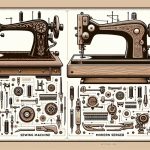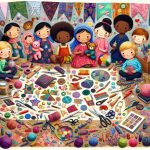Are monogramming machines easy for fabric beginners?
Mastering monogramming may seem daunting, but with the right guidance, you can confidently create personalized fabric pieces. Understanding the key features and functions of monogramming machines will set you on the path to mastery.
This introduction will provide clear and precise insights into the world of monogramming, helping you navigate through the initial challenges and expand your skills. Whether you're a sewing enthusiast or a novice in the fabric arts, this guide will equip you with the knowledge to make monogramming an accessible and enjoyable craft.
Key Takeaways
- Understanding the different types of stitches and designs achievable with a monogramming machine is important for fabric beginners.
- Proper fabric preparation before monogramming, such as using stabilizers and hooping techniques, greatly impacts the quality of monogrammed creations.
- When selecting a monogramming machine, fabric beginners should consider features such as budget, machine compatibility, customization options, and design software integration.
- Fabric beginners should also focus on learning the basic functions of a monogramming machine, including machine setup, threading, stitch patterns, and troubleshooting techniques.
Understanding Monogramming Machines
If you're new to fabric crafting, you may find that understanding monogramming machines can be a bit overwhelming at first. However, with the right guidance, you can quickly grasp the essential monogramming techniques and fabric preparation.
When it comes to monogramming techniques, it's crucial to understand the different types of stitches and designs that can be achieved with a monogramming machine. This includes satin stitch monograms, block lettering, and script fonts, among others. Familiarizing yourself with these techniques will allow you to create intricate and personalized designs on fabric with ease.
In addition to mastering monogramming techniques, fabric preparation is equally important. Before you begin monogramming, it's crucial to ensure that the fabric is clean, pressed, and stabilized to prevent any distortions during the stitching process. Understanding the appropriate stabilizers and hooping techniques for different types of fabric will significantly impact the quality of your monogrammed creations.
Key Features to Look for
When selecting a monogramming machine as a fabric beginner, look for key features that include user-friendly interfaces and versatile stitching options. Consider machine compatibility with your fabric choices, as some machines may not work well with certain types of fabric.
Additionally, keep your budget constraints in mind and opt for a machine that offers a good balance between affordability and quality. Look for customization options that allow you to create unique designs and patterns, as this will help you personalize your projects. Integration with design software can also be a crucial feature to consider, especially if you plan to create intricate and detailed monograms.
This feature will enable you to import and digitize your own designs, opening up a world of creative possibilities. Ultimately, prioritize a machine that offers a seamless user experience, supports your fabric choices, fits your budget, and provides ample customization and design software integration to meet your creative needs.
Getting Started With Basic Functions
So, you've just gotten your hands on a monogramming machine and you're ready to dive into the world of fabric customization.
First things first, let's talk about getting started with the basic functions. This includes setting up the machine and understanding the different stitch types it offers.
Machine Setup and Operation
You can easily set up and operate a monogramming machine by following the manufacturer's instructions and familiarizing yourself with its basic functions. To get started with the machine, consider the following:
- Read the user manual thoroughly and understand the different parts of the machine.
- Practice threading the machine, including the needle and bobbin, to ensure smooth operation.
- Experiment with different stitch patterns and thread tensions to understand how they affect the final output.
- Learn basic troubleshooting techniques for common issues such as thread breakage or jamming.
Understanding Stitch Types
To understand stitch types and get started with basic functions, familiarize yourself with the different options available on the monogramming machine. Different stitch options can create various effects on your embroidery design, so it's essential to understand how each one works. Additionally, understanding thread tension is crucial for achieving high-quality embroidery. Below is a table summarizing some common stitch types and their functions:
| Stitch Type | Description | Best Use |
|---|---|---|
| Running Stitch | Basic straight stitch | Outlining |
| Satin Stitch | Dense, smooth, solid line | Filling large areas |
| Zigzag Stitch | Sturdy, versatile stitch | Attaching applique, edges |
When choosing a stitch type, consider your embroidery design and hoop size for optimal results. Understanding these basic functions will set you on the path to mastering your monogramming machine.
Tips for Choosing Suitable Fabrics
When choosing fabrics for your monogramming projects, consider the weight of the fabric to ensure it's suitable for the design and usage.
Look for versatile fabrics that can be used for a variety of projects, providing you with more value for your investment.
Additionally, prioritize fabrics that are durable and easy to maintain to ensure your monogrammed creations last.
Fabric Weight Considerations
Consider the weight of the fabric when choosing suitable materials for monogramming projects. Fabric thickness and needle size should match to ensure the needle can penetrate the fabric without causing damage.
Additionally, fabric stretch should be taken into account, especially when working with stretchy fabrics like knits. Using a stabilizer can help prevent distortion and puckering in lightweight or stretchy fabrics, providing a stable base for the monogram.
When selecting fabrics for monogramming, keep in mind that heavier fabrics may require a larger needle size and a more robust stabilizer to support the stitching, while lighter fabrics may need a finer needle and a lighter stabilizer.
Remember to test different fabric weights with your monogramming machine to find the best combination for your project.
Versatility of Fabric
When working with monogramming machines, you should prioritize versatile fabrics that will perform well under the stitching process. Consider fabric types such as cotton, linen, and twill, which are known for their durability and adaptability to various stitching techniques. These fabrics provide a stable foundation for monogramming and can withstand the repeated needle penetrations without puckering or distorting the design.
Additionally, when choosing fabrics for monogramming, consider their suitability for fabric printing. Fabrics with a smooth and even surface, like cotton and satin, are ideal for showcasing intricate monogram designs. Avoid overly stretchy or delicate fabrics, as they may pose challenges during the monogramming process.
Durability and Maintenance
To ensure the durability and maintenance of your monogrammed fabrics, select suitable fabric types that can withstand repeated needle penetrations and are easy to maintain. When choosing fabrics for monogramming, consider the following tips:
- Opt for durable fabrics like cotton, denim, or twill that can endure repeated stitching without fraying or tearing.
- Choose fabrics with a tight weave to prevent excessive puckering or distortion of the monogram design.
- Prioritize fabrics that are easy to clean and maintain, such as machine-washable options, to ensure long-term durability and easy repairs.
- Consider the longevity of both the fabric and the monogramming machine when selecting suitable fabrics for your projects.
Troubleshooting Common Beginner Issues
If you encounter thread tension issues with your monogramming machine, try adjusting the tension settings using the machine's manual as a guide. Improper tension can lead to thread breakage or loose stitches.
Ensure the thread is correctly threaded through the machine and the needle to prevent tension problems. Needle breakage is another common issue for beginners. This can occur due to using the wrong needle for the fabric, a bent needle, or the needle not being properly inserted. Use the appropriate needle size and type for the fabric being embroidered. Inspect needles regularly and replace them if they're bent or damaged. Additionally, make sure the needle is correctly inserted and tightened.
Bobbin issues can also cause problems. Ensure the bobbin is correctly wound and inserted. If the bobbin thread isn't properly placed, it can result in thread bunching or breaking.
Regular maintenance, such as cleaning the machine and changing needles and bobbins, can prevent many common beginner issues. Refer to the machine's manual for troubleshooting tips specific to your monogramming machine.
Expanding Your Skills With Advanced Techniques
To further advance your monogramming skills, consider mastering advanced stitching techniques and exploring creative design options beyond basic monogramming. By delving into advanced embroidery, you can elevate your projects and create stunning custom designs that showcase your expertise.
Here are some ways to expand your skills and take your monogramming to the next level:
- Experiment with intricate stitching patterns to add depth and texture to your designs.
- Learn how to incorporate specialty threads, such as metallic or variegated threads, to enhance the visual impact of your monograms.
- Explore advanced digitizing software to create personalized designs, intricate borders, and decorative elements that go beyond traditional monogramming.
- Practice embroidery on challenging fabrics like denim, leather, or knits to hone your skills and broaden your capabilities.
Frequently Asked Questions
Can Monogramming Machines Be Used for Embroidery as Well?
Yes, monogramming machines can be used for embroidery as well. They offer compatibility for various stitching techniques and design transfer methods. With practice, you'll master the art of using monogramming machines for embroidery.
How Do I Maintain and Clean My Monogramming Machine?
To maintain and clean your monogramming machine, start by regularly oiling moving parts and wiping down surfaces with a cloth. Check the manual for specific instructions. For fabric beginners, it's important to keep your machine well-maintained for smooth operation.
Are There Any Safety Precautions I Should Be Aware of When Using a Monogramming Machine?
When using a monogramming machine, always follow safety precautions such as wearing protective gear and keeping hands away from moving parts. Regular machine maintenance is essential for safe operation, including keeping the workspace clean and lubricating moving components.
Can Monogramming Machines Work With Different Types of Thread?
Yes, monogramming machines can work with different types of thread. It's important to ensure machine compatibility and adjust thread tension for optimal stitch quality. Experimenting with various threads will help you understand their behavior.
How Do I Transfer Designs Onto the Monogramming Machine for Stitching?
To transfer designs onto the monogramming machine, use a USB or connect to a computer. Select your design and stitching techniques, then upload it to the machine. Once loaded, the machine will be ready for stitching.
- Tetron Fabric for Marine Applications: Durability and Use Cases - June 18, 2025
- Tetron Fabric for Outdoor Furniture: Weather Resistance and Care - June 18, 2025
- Tetron Fabric for Wall Coverings: Style and Application Tips - June 18, 2025





